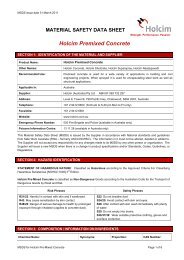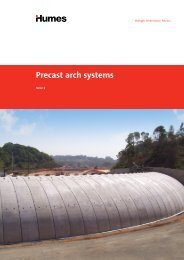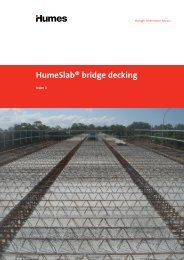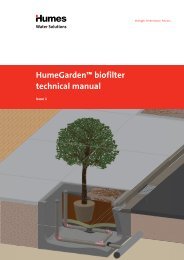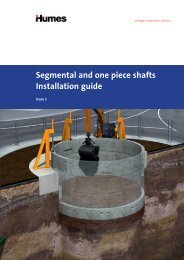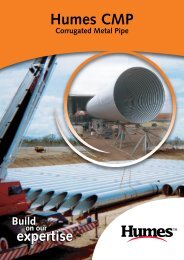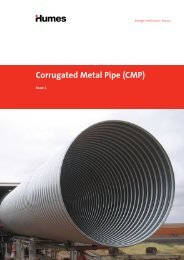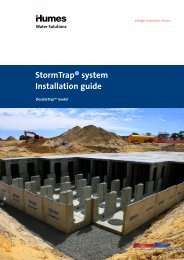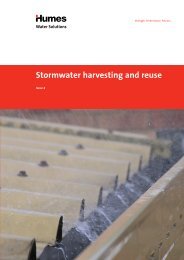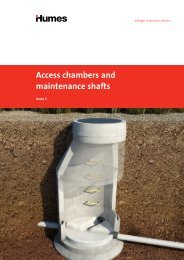Plastiline™ - Humes
Plastiline™ - Humes
Plastiline™ - Humes
You also want an ePaper? Increase the reach of your titles
YUMPU automatically turns print PDFs into web optimized ePapers that Google loves.
9 Incorporation of keyed Plastiline<br />
in cast insitu concrete structures<br />
9.1 The Plastiline must cover the areas specified and is<br />
secured to the inner formwork face prior to placing the<br />
concrete and reinforcement. Formwork used must be<br />
suitable for proper attachment of the plastic sheet.<br />
The preferred method of attachment of the sheet is by<br />
nailing or stapling directly to timber forms, or to timber<br />
nailing strips set in steel forms at the appropriate<br />
positions. Nails shall be of approved small flat-headed<br />
type. All fasteners must be placed within 7mm of the edge<br />
of the sheet so that holes will be covered by the welding<br />
strip. If it is necessary to secure a joint flap a temporary<br />
form support must be used and the flap must be fastened<br />
within 7mm of its edge.<br />
Alternatively, it can be held to steel forms by light metal or<br />
plastic bands tightened on to suitable attachments to the<br />
forms. Provision must be made to maintain the sheet in<br />
close contact with the form during concrete placement.<br />
Bands must be of the type recommended by <strong>Humes</strong>.<br />
If the bands cross the keys, provision must be made to<br />
ensure that the keys are not bent or distorted.<br />
All pipe or other metal inserts must be held firmly in place<br />
on the formwork and, where required, the Plastiline<br />
protection of these inserts must first be installed. Metal<br />
form ties shall be kept to a minimum.<br />
9.2 In the case of large floors or the bottoms of large<br />
tanks etc the alternatives are:<br />
i) Where there is no external hydrostatic head or other<br />
potential uplift, plain Plastiline sheet or blankets can be<br />
loose-laid or bonded to the base slab with an adhesive<br />
approved by <strong>Humes</strong>.<br />
ii) Where the base can be subject to pressure from<br />
external ground water, Plastiline should be embedded<br />
into the top of the slab, using a vibrating screed. This<br />
vibrator is applied after bleeding has ceased, but before<br />
initial set occurs.<br />
As it is essential to insert the keys before the concrete<br />
hardens, it may be necessary to limit the area of each pour.<br />
iii) After vibrating the Plastiline into position, if<br />
sheets/blankets overlap, care must be taken to ensure<br />
concrete mortar is cleared from welding areas prior to the<br />
complete hardening of the concrete.<br />
9.3 Unless otherwise specifically indicated, Plastiline<br />
blankets shall be positioned so that the locking keys are<br />
vertical or as near vertical as possible to provide a free<br />
escape to the bottom of fluid which may accumulate<br />
between the lining and wall of the structure. Where the<br />
locking keys cannot be positioned vertically a gap of<br />
between 75mm and 100mm width shall be provided by<br />
cutting off the locking keys at intervals not greater than<br />
2.5m longitudinally, to provide weep channels. A weep<br />
channel shall be provided approximately 300 mm away<br />
from all lining returns.<br />
Where changes in direction or corners are encountered, the<br />
Plastiline may be bent and secured to the form, provided<br />
the radius of the blend is not less than 25mm.<br />
Where sharper corners are specified, a jointing method<br />
approved by <strong>Humes</strong> must be used.<br />
9.4 For lining joints which do not correspond to joints<br />
in the concrete structure, the Type C3 joint is preferred. For<br />
this joint the Plastiline sheets are butted together,<br />
so that the gap between sheets and/or blankets at<br />
any position does not exceed 4mm. This gap must be<br />
temporarily sealed by a wide PVC tape before placing<br />
concrete. After form removal a flat welding strip, centred<br />
over the gap, is welded to give a permanent and<br />
continuous lining on the inside of the structure.<br />
As an alternative, the lap joint Type C2 may be used.<br />
This joint requires that the Plastiline be lapped at least<br />
35mm, the overlap or flap being on the downstream side<br />
of the joint. A Type C2 joint must be at longitudinal<br />
construction joints in concrete structure.<br />
For Plastiline lining joints at transverse construction or<br />
contraction joints in the concrete structure, a Type C1 joint<br />
must be used.<br />
Normal jointing method C1<br />
This is identical with type P1<br />
Normal jointing method C2<br />
Note: Type C1 Joint is identical with type P1<br />
Min. overlap 35mm<br />
Flat Welding Strip<br />
Direction of flow<br />
PVC Tape<br />
Use seam weld or apply pvc<br />
tape before placing concrete.<br />
Method of jointing Plastiline in structure without joint.<br />
Not to be used where transverse construction or<br />
contraction joint occurs. Shall be used where a<br />
longitudinaL construction joint intersects with a joint<br />
in the Plastiline.<br />
Normal jointing method C3<br />
Apply welding strip after stripping formwork<br />
Plastiline<br />
Method of jointing sheet, except where construction or<br />
contraction joint occurs, should be used when longitudinal<br />
construction joint intersects with a joint in the Plastiline.<br />
Shall not be used where transverse construction or<br />
contraction joint occurs.<br />
13



